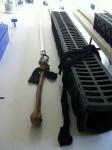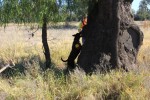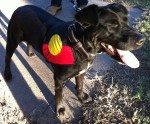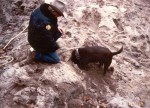 Gary Jackson, owner of Multinational K9 Dog Training in Brisbane, Australia, has been training dogs in everything from basic obedience to highly specialized detection for government and corporations for decades. Now he can add another specialty to his roster of pioneering cane toad, koala and quoll detection dogs: Migaloo, the world’s first dog trained to detect archaeological human remains.
Gary Jackson, owner of Multinational K9 Dog Training in Brisbane, Australia, has been training dogs in everything from basic obedience to highly specialized detection for government and corporations for decades. Now he can add another specialty to his roster of pioneering cane toad, koala and quoll detection dogs: Migaloo, the world’s first dog trained to detect archaeological human remains.
 Unlike cadaver dogs, which use their advanced olfactory senses to detect the scent of decomposing human flesh, Migaloo detects bones hundreds of years old, and not just an entire skeleton but even tiny fragments of bone no larger than a tooth. Jackson spent six months training the Labrador mix using 250-year-old Aboriginal bones (handled with the utmost respect according to Aboriginal traditions) on loan from the South Australian Museum. The bones were placed in protective tubes with a ventilation chamber attached that allows the scent to filter through. The human remains were then buried in an impromptu graveyard/proving ground at depths ranging from one to three feet. Numerous animal bones — including kangaroo, horse, chicken, cat — were scattered around as decoys. Migaloo quickly became adept at detecting and indicating only the human bones from as far away as 20 feet, detecting even the traces of bones that had been present 24 hours earlier and then removed.
Unlike cadaver dogs, which use their advanced olfactory senses to detect the scent of decomposing human flesh, Migaloo detects bones hundreds of years old, and not just an entire skeleton but even tiny fragments of bone no larger than a tooth. Jackson spent six months training the Labrador mix using 250-year-old Aboriginal bones (handled with the utmost respect according to Aboriginal traditions) on loan from the South Australian Museum. The bones were placed in protective tubes with a ventilation chamber attached that allows the scent to filter through. The human remains were then buried in an impromptu graveyard/proving ground at depths ranging from one to three feet. Numerous animal bones — including kangaroo, horse, chicken, cat — were scattered around as decoys. Migaloo quickly became adept at detecting and indicating only the human bones from as far away as 20 feet, detecting even the traces of bones that had been present 24 hours earlier and then removed.
 Wearing her stylish new custom-made jacket with an Australian Aboriginal Flag design, Migaloo successfully conducted her first operational find at an undisclosed location in the Queensland outback in May of this year. After searching miles of terrain and hundreds of trees for traces of historical burials, she indicated strongly on one Eucalyptus tree. The team surveyed the hollow tree non-invasively and indeed found archaeological human remains, buried inside the tree according to an ancient Aboriginal funerary practice. The bones were not disturbed by request of the traditional owners of the land.
Wearing her stylish new custom-made jacket with an Australian Aboriginal Flag design, Migaloo successfully conducted her first operational find at an undisclosed location in the Queensland outback in May of this year. After searching miles of terrain and hundreds of trees for traces of historical burials, she indicated strongly on one Eucalyptus tree. The team surveyed the hollow tree non-invasively and indeed found archaeological human remains, buried inside the tree according to an ancient Aboriginal funerary practice. The bones were not disturbed by request of the traditional owners of the land.
 In field tests over the next few months Migaloo again performed admirably, but it was her test on August 14th that was a record-breaker. On an Aboriginal burial ground on Yorke Peninsula in South Australia, Migaloo found four burial spots, one of them 600 years old and 8 feet underground. It has never been excavated and was known only because a post-hole digger found a bone fragment deep under the surface which was radiocarbon dated to 600 years ago. That’s a world record, as far as we know.
In field tests over the next few months Migaloo again performed admirably, but it was her test on August 14th that was a record-breaker. On an Aboriginal burial ground on Yorke Peninsula in South Australia, Migaloo found four burial spots, one of them 600 years old and 8 feet underground. It has never been excavated and was known only because a post-hole digger found a bone fragment deep under the surface which was radiocarbon dated to 600 years ago. That’s a world record, as far as we know.
 The oldest human remains detected by canine before now were 175 years old. In December of 1987, Candy, a chocolate Lab cadaver dog handled by legendary law enforcement dog trainer Bill Tolhurst, indicated human remains on a spot in Fort Erie, Ontario, Canada. The archaeologists didn’t have funding to excavate the spot at that time, but once the money came through they excavated the place Candy had pointed to and found three skeletons of men killed during the Battle of Snake Hill during the War of 1812. That record has stood until now.
The oldest human remains detected by canine before now were 175 years old. In December of 1987, Candy, a chocolate Lab cadaver dog handled by legendary law enforcement dog trainer Bill Tolhurst, indicated human remains on a spot in Fort Erie, Ontario, Canada. The archaeologists didn’t have funding to excavate the spot at that time, but once the money came through they excavated the place Candy had pointed to and found three skeletons of men killed during the Battle of Snake Hill during the War of 1812. That record has stood until now.
Migaloo’s abilities are an exciting development for archaeologists in Australia and around the world. Candy wasn’t trained to specifically pick up archaeological remains. Her regular job was working with the police to find cadavers. If Migaloo can be trained to find human skeletal remains that are hundreds, maybe thousands of years old, she and other dogs like her will be a powerful new tool for archaeologists.
Red Centre Consultancy director Bud Streten, who owns Migaloo, plans to use her as a non-invasive way of locating and protecting traditional burial sites.
“It is a massive breakthrough, not only here in Australia but we’ve got some interest from overseas for use in other ancient civilisations.
“At the moment in the world of archaeology there is no tool that can tell you there are human remains underground, we use ground penetrating radar, magnetic susceptibility and historical or oral records.
“But now Migaloo the wonder dog can do it.”
See Migaloo perform her record-breaking feat of findery in the following YouTube video. Protip: you’ll want to turn the volume way up when Quenten Agius of the Adjahdura Land Traditional Owners Group speaks because his voice is much more quiet than anyone else’s. Follow Migaloo’s future adventures on her Facebook page.
[youtube=http://www.youtube.com/watch?v=r-G2RJjZVP8&w=430]
Now I’ll never get any rest. :angry:
Woof! That’s quite the nose. I wonder if the technique requires drier soils.
Congratulations this is a very well written article
Gary Jackson
Migaloo’s trainer
Thank you! If I did Migaloo’s awesomeness justice, that’s more than enough for me. Congratulations to you on your phenomenal work training Migaloo. :thanks:
Years ago my sister had an archeology professor who did field work in Greece (wish I could remember where). According to him, certain of the locals had a knack for the unassuming dirt cakes that happened to have Archeologically Interesting Stuff inside. How did they know????
Some local instinct, it seemed, much as with the dog.
Oh yes, that sort of local understanding of the terrain is how looters do their best work. In Italy, for instance, tombaroli look for certain patterns of earth and plant growth as indicators of a potential Etruscan tomb beneath. They can’t sniff out bone, however. Thankfully!
(Okay, smell is not an instinct, but you know what I mean.)
Somewhere in Dennis’s Cities and Cemeteries of Etruria there is a description of tomb robbers who, disgusted that the lasted dig produced no silver or gold, only delicate balck bucherro, crush it underfoot in contempt despite the entreaties of Mr Dennis.
Weep worthy stuff, that.
Good dog.
Uh, where’d you get that bone?
What will they think of next
BENJAMIN MARCUS RAUCHER
Another media release for migaloo in the next few weeks this one is huge 600 years is nothing compared to this new find. stay tuned
Gary Jackson
This is just too wonderful. As a dog person and a pioneer cemetary conservationist I am over the moon about the possibility of finding a dog to help me find unmarked graves in old pioneer cemetaries here in Eastern Ontario Canada just across the border from northern New York state.
Any contacts around here?
https://www.youtube.com/watch?v=xNDwhN6mfjE